Six-Day War 50th Anniversary: Middle East Blitzkrieg [Part Three]
June 21, 2017 by oriskany
Good afternoon, Beasts of War. Today we’re closing out our three-part article series commemorating the Six-Day War. Fought in June 1967, this war saw the IDF (Israeli Defence Force) engage and soundly defeat the forces of Egypt, Jordan, and Syria in one of the most stunning campaigns in recent military history.
If you’re just joining us, please check out our previous parts. In Part One we briefly reviewed the Arab-Israeli Wars up to 1967, looked at the roots of the Six-Day War, and discussed the initial Israeli air strikes that set the war in motion. In Part Two we looked at the war’s largest battles, fought between Israel and Egypt in the Sinai Peninsula.
But there’s plenty more to cover, with fighting still to come between Israel and Jordan in the West Bank and Old Jerusalem…and between Israeli and Syria in the fateful Golan Heights overlooking the biblical lands of Galilee.
War In The West
Israel vs. Jordan (June 5th-7th)
Israel had planned exhaustively for war with Egypt and Syria, but the entry of Jordan into the war came as a bit of a surprise. Israeli Prime Minister Levi Eshkol contacted Jordan’s King Hussein before the shooting started and promised that if Jordan stayed out of the conflict, Israeli would respect her neutrality.
Unfortunately, Jordan had been pushed into joining the conflict by Egypt and Syria. Although more advanced than the Egyptian or Syrian armies, the Royal Jordanian Army and Air Force were far smaller and nowhere near prepared for a showdown with Israel. Egypt also lied about how the war was going so far, claiming huge wins over Israel.
Thus, about three hours after the Israeli Air Force (IAF) had struck targets in Egypt (June 5th, 1967), Jordanian artillery opened fire into Israel from positions in the West Bank. Israel responded with air strikes into Jordan, wiping out their air force much as they’d done to Egypt and Syria earlier that morning. Then the ground war started in earnest.
Israeli objectives for the war with Jordan were two-fold: take the entirety of the city of Jerusalem (the city had been partitioned between Israel and Jordan since 1948), and take all of the West Bank (Jordanian land extending beyond Jerusalem to the “west bank” of the Jordan River).
The Battle for Jerusalem in 1967 began where the War of 1948 left off. Israeli mechanised units and tanks advanced north of the city, Colonel Asher Dar’s “Jerusalem Brigade” advanced south of the city, and paratroopers in halftracks pushed into the city itself. The objective was to cut the city off from the Jordanian Army in the West Bank.
Meanwhile, a larger campaign had started with Israeli spearheads striking deeper into the West Bank. Ramallah, Bethlehem, and Jericho all saw action, but the biggest battle was in the north at Jenin. Here, Israeli tanks of Peled’s Division ran into Jordanian infantry and tanks of the 25th Brigade.
For a time, the Battle of Jenin looked as if it might end in stalemate, with a Jordanian armoured brigade coming up to reinforce the brave 25th. But IAF strikes mauled the approaching Jordanian tanks (ironically, the same M48A2s the Israelis were using). Left on their own, the Jordanians at Jenin were soon bypassed, encircled, and defeated.
Meanwhile, fierce fighting raged through Jerusalem and its surrounding suburbs. Despite being cut off, troops of the Jordanian 27th Brigade (Brigadier-General Ata Ali) and other units put up fierce resistance at places like the Latrun Road, Ammunition Hill, Mount Scopus, the UN Compound, and the streets leading to the Temple Mount.
But the Israelis were not to be stopped. With upgraded Sherman tanks in the streets alongside infantry of the elite 55th Parachute Brigade, they soon cleared resistance and reached the Western Wall. This wall holds immense symbolic importance to the Jewish people, last remaining fragment of the Second Temple, destroyed in 70 A.D.
War In The North
Israel vs. Syria (June 9th-10th)
The last part of the war came in the north, where the Israelis faced the Syrian Army. The Syrians were dug in along the Golan Heights, a tall plateau of volcanic rock running north to south, almost forming an immense topographical “wall” ten to fifteen miles wide between Syria and Israel.
Between these two hostile states, possession of this “wall” is critical. Whoever has it commands the high ground for any potential battlefield between the two nations, and can see deep into the enemy’s territory. For years Syrians had used this advantage to shell Israeli settlements in Galilee with artillery and rocket fire.
Possession of the Golan provides further leverage in the form of water. It's relatively green and moist up there, at least compared to the surrounding deserts. Whoever owns the Golan commands irrigation for agriculture for miles on both sides of the border, another advantage the Syrians used against their Israeli foes.
In many ways, Syria didn’t want the Six Day War. They’d only gotten involved when Soviet intel falsely reported that Israel was preparing to invade Syria. This was exposed as a blatant “false flag” operation designed to strengthen Syrian dependence on Moscow, yet even when this ruse was exposed, it was too late. War was already inevitable.
When the fighting started, Syria tried to make a show of being involved without becoming too heavily engaged. They tried bombing some Israeli targets, the IAF wiped out their air force. After that, they shelled some Israeli positions, but while the Egyptians and Jordanians were heavily engaged and defeated, the Syrians largely did nothing.
The Israelis took the war to Syria, however, starting on June 9. Starting at the extreme northern tip of the Golan, a brigade of tanks under Colonel Mandler and the crack “Golani” infantry brigade took heavily fortified Syrians only after a desperate and blood-soaked flanking attack in which both Syrians and Israelis showed incredible bravery.
Two more Israeli infantry brigades supported this offensive’s southern shoulder, pushing across the Jordan River, hooking northeast, and linking up with the bloodied Israelis coming down from the north. Together they drove on Quneitra, largest town on the Golan and astride the highway leading straight to Damascus, the capital of Syria.
By June 10th, the last day of the war, Israeli forces that had helped win the West Bank had been shifted to the Golan and were hitting the Syrians from the south. Tanks of General Peled’s division leap-frogged over helicopter paratroopers and soon took Rafid, overlooking inner Syria, before the UN cease-fire took effect at 18:30 hours.
Assessment
Needless to say, the 1967 Six-Day War was a stunning military success for Israel. But how did such a one-sided war happen?
First off, on a strategic level, Israel was able to win because she struck first with a dazzling blow, then scored lightning victories against her opponents before they could recover and coordinate. If Egypt, Syria, and Jordan had all been able to fight Israel at once, the outcome would’ve been very different.
Tactically, Israeli training was far superior. Whereas Syrian and Egyptian armies had invested in numbers and considered sheer size as a strength, Israel (with fewer resources to call upon) concentrated on making the most out of the soldiers, tanks, and aircraft they had. Hardened, all-or-nothing motivation also proved a key edge for the Israelis.
Israel’s victory in 1967 would have far-reaching, if often unintended, consequences. Most immediately, Israeli was safe for the time being. Not only had the militaries of her enemies been crippled, but Israel had won strategic depth in the Sinai, West Bank, and Golan Heights, “buffer” ground that could be traded for time in future wars.
But the newly-occupied territories also presented new problems. For one, a Palestinian resistance movement was quick to ignite in conquered territories like Gaza and the West Bank, which causes immense problems to this day. Displaced Palestinians in Jordan would also cause problems, including a brief war between Jordan and Syria in 1970.
The uncertain peace that followed the Six-Day War would also see the governments of Syria and especially Egypt seethed for revenge. From 1967-1970 simmered the “War of Attrition,” a low-intensity state of constant skirmish that saw the Suez Canal become (for a time) the most heavily fortified line on Earth.
But most of all, the Six-Day War “taught” the IDF that they were vastly superior to their “feeble” Arab opponents. Yet as Friedrich Nietzsche wrote: “war makes the victor stupid.” The Egyptians, in particular, would rebuild their army along totally new lines, and return in 1973 to greatly redeem themselves against the IDF in the Yom Kippur War.
Wargaming Notes
So what features and elements should a wargame include in order to recreate some of the conditions found in the Six-Day War?
The opposing armies must have dramatically different feels. The Israelis are light, fast, well-trained, and small in number. You can’t make a mistake with them, their units should be fragile and expensive. Egyptians and Syrians, on the other hand, should have big numbers, low point costs, but be hard to handle in mobile or offensive operations.
Yet just as the Israelis are great in attack, the Syrians and especially the Egyptians should be rocks in defence. Arab artillery and infantry should be weapons to be truly feared, and always be liberal with mines, blocks, fortifications, and improved positions. These armies could dig in and entrench like few others in modern warfare.
Finally, games should have asymmetrical victory conditions. Let’s face it, in any historically-accurate Six-Day War game, the Israelis are almost certain to win. The trick is to make their victory requirements very tough so even an unfair BATTLE can become a fair GAME that is enjoyable and challenging for both players.
In at least a few regards, the Arab-Israeli Wars are perfect for wargames. Compared to World Wars, these fights are small and short, and thus more manageable. They also use a great deal of World War II or Cold War equipment players may already have, making it easy to convert armies to explore a new area of history.
Another bonus is the victory conditions. In games from other wars, these can feel a little “gamey” … take a certain bridge by turn eight because that’s when the game ends no matter what, that kind of thing. Believe it or not, these factors sometimes fit perfectly in an Arab-Israeli War context.
Historically, the instant the first shot was fired in these wars, people were on the phone to Washington, Moscow, and the UN to end them. Both sides thus want to take or defend whatever they could, knowing the war could suddenly end “out of nowhere,” and these objectives would make important bargaining chips in the post-war talks.
Give It A Go Yourself
That wraps up our 50th Anniversary article series on the Six-Day War. I hope you’ve enjoyed reading them, and just maybe picked up a little extra knowledge or gaming inspiration. As always, I’d like to thank @brennon and @lancorz for helping me publish material on the Beasts of War site, and always make my material look so great.
Most of all, of course, I’d like to thank all of you, all the Beasts of War community members who have taken the time to plough headlong through the verbose ramblings of a would-be historian and inveterate madman. Your patience and curiosity, and the tireless support of @warzan have meant worlds to me.
So I hope you’ll take just one moment more and drop a comment below. Best of all, if you’ve tried a wargame set in the Arab-Israeli Wars (Avalon Hill’s classic, Avalanche Press’ Sword of Israel, IDF, Fate of a Nation by Battlefront, Flashpoint: Golan, Yom Kippur, Crisis: Sinai 1973, Jerusalem 1948, etc.), tell us about your wargaming experience!
If you would like to write an article for Beasts of War then please contact us at [email protected] for more information!
"In many ways, Syria didn’t want the Six Day War. They’d only gotten involved when Soviet intel falsely reported that Israel was preparing to invade Syria..."
Supported by (Turn Off)
Supported by (Turn Off)
"So what features and elements should a wargame include in order to recreate some of the conditions found in the Six-Day War?"
Supported by (Turn Off)

































![TerrainFest 2024! Build Terrain With OnTableTop & Win A £300 Prize [Extended!]](https://images.beastsofwar.com/2024/10/TerrainFEST-2024-Social-Media-Post-Square-225-127.jpg)







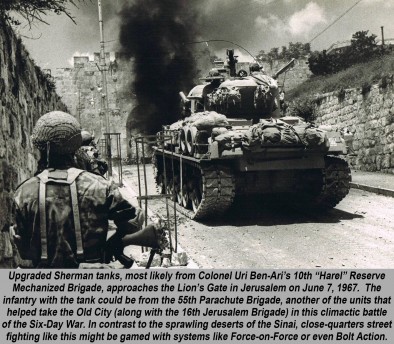
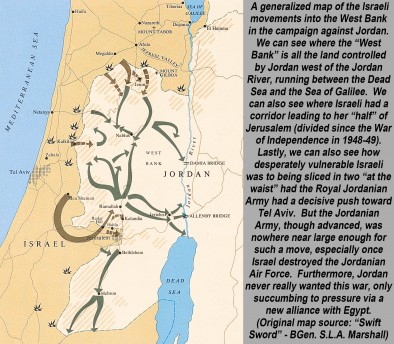
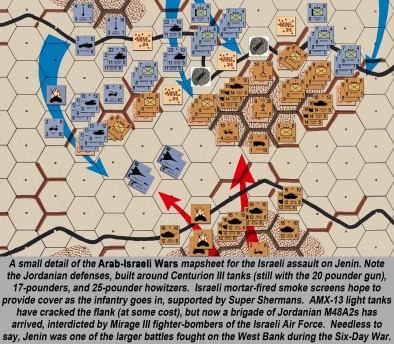
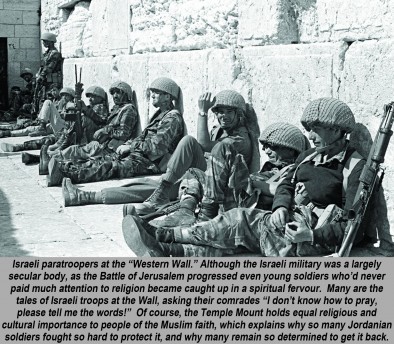
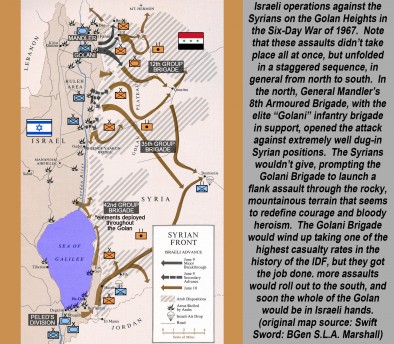
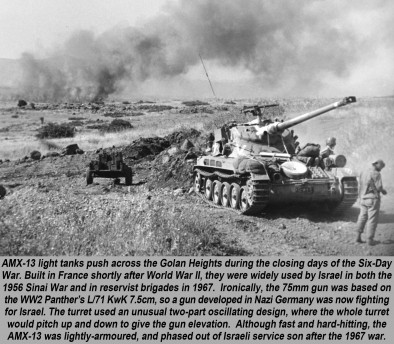
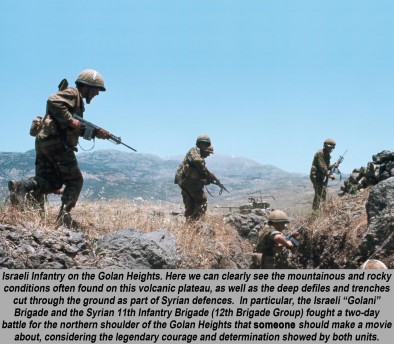
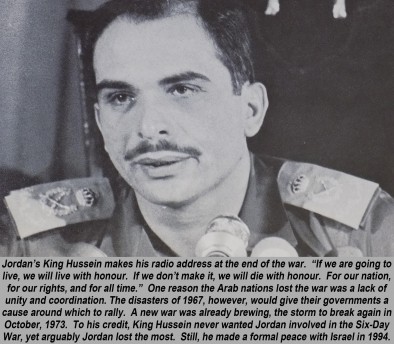
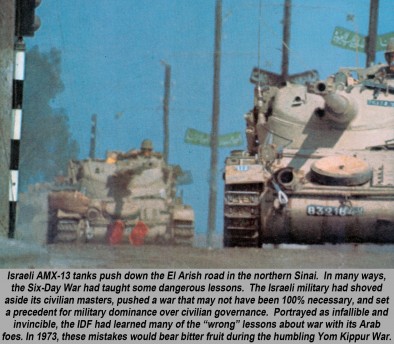
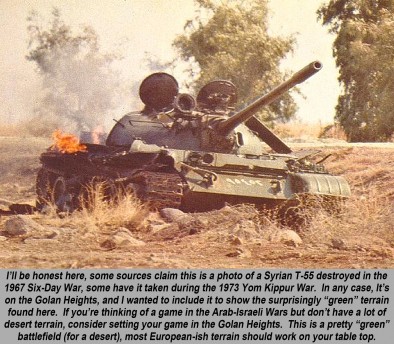



































Great finale. It’s crazy how much double dealing there was behind the scenes. More than one battlefield in play here, I guess.
Thanks for kicking us off, @gladesrunner . Yeah, there is a very strong political, espionage, and diplomatic element to all of these Arab-Israeli Wars, and the wars are small and short enough to where these factors really reach down and “touch” the battlefield at the tabletop level. This can make the victory conditions that sometimes seem very “gamey” in some games actually make sense in an Arab-Israeli Wars setting. e.g., take this hill by the end of Turn 8 because … on Turn 8 the war magically ends? Actually, yes. These wars usually ended with a phone call from the… Read more »
https://m.facebook.com/story.php?story_fbid=10154481092280880&id=1767886810189145
Found this on Facebook
Thanks, @dugthefug1644 – and that’s a great little animation. 😀 Still, a little bit of a political ax to grind in there, isn’t there? Nothing like an impartial, unbiased view, eh? Definitely presents one side of the issue, and not the other. I couldn’t help but notice they skipped straight from the 1948 to the 1967 War, completely ignoring Israel’s invasion of the Sinai in 1956 with the approval and cooperation of the French and British. Still, there is some good information there (Syria’s diversion of the water supply, mentioned in the article above … and Egypt’s closure of the… Read more »
I will say this, at least they give Sadat and King Hussein their due. 😀 😀 😀
Was just presenting as exhibit A as to why you should follow an Oriskany multi part article series rather than getting your knowledge from Facebook. 🙂 I don’t pretend to understand the politics and centuries old hatred from my quiet suburb of London. Got taught early from my brilliant History teachers that you always look for bias before you read or listen to any source and judge it accordingly. If I read something and feel offended I take a step back, consider who wrote it and why they wrote and consider it again. Found your series really interesting. Going to… Read more »
Thanks, @dugthefug1644 – I sincerely hope I didn’t come across like I was coming after you in my post. Definitely not the case. The people who made that video, however … 😀 And of course nothing they say in there is factually wrong (substantially). However, Bias often comes in what you DON’T say as much as what you DO say. I did some “heavier” writing about ten years ago for the Yom Kippur War, and man, you had to read a dozen books before you even had a clue where the “truth” was. None of the reference materials really had… Read more »
The trouble is that we can often assume that the best reports of what happened come from eye witnesses, but when people go through the horrors of a conflict how many come out the other side without a bias? Glad you were able to tackle a potentially sticky time period so well. I enjoyed a well visited forum here a year or two ago about should we be concerned about what you field in game if the troops committed atrocities or fought for values that are objectionable today (i.e. SS troops in Bolt Action). Should Confederate flags be displayed prominently… Read more »
Thanks, @dugthefug1644 – The trouble is that we can often assume that the best reports of what happened come from eye witnesses Very true. We were briefly having this conversation on one of the Midway threads about the catch-22 posed by first-hand sources . . . priceless and irreplaceable on one hand, but of course always emotionally involved in the subject matter (how could you not be when you live through experiences like that). I enjoyed a well visited forum here a year or two ago about should we be concerned about what you field in game if the troops… Read more »
great ending the middle east was/is a pit of vipers with each trying to out deal the other to get political strength from one power or another. the AX13 reminds me of a updated infantry support tank? @oriskany
The AMX-13 is a neat little tank. The turret comes in two parts that rotate inside each other almost like a ball-and-socket joint, allowing traverse and elevation (the gun itself does not depress or elevate like in most tanks). Fast little buggers in Arab Israeli Wars you have to keep an eye on them as they’re the first ones around your flank. Ironically, the gun was originally based on the gun in Germany’s WW2 Panther tank. So a gun originally designed to fight for Nazi Germany winds up fighting for Israel. In the 1948 War of Independence Israel also used… Read more »
Did I go wrong or have I found a historical site, called Beast of War? 😉
We finally made it happen, @rasmus ! 😀 😀 😀
Few wars lasted as short and cast as long a shadow, as this one
Ironically the subsequent Yom Kippur War was bigger, longer, more destructive, more dangerous to Cold War tensions, and more bitterly fought . . . yet in a relatively short time span actually led to a final settlement between Israel and Egypt (the main Arab state player in the wars against Israel). Whereas the Six-Day War . . . you’re right . . . has left serious scars to this day in the Golan, the Gaza, and Wet Bank.
Again, my knowledge of this conflict is limited. I was aware of the rapid domination by the Israeli Air Force, but thought the attacks of Jordan and Syria were coordinated with that of Egypt.
Did any reinforcements from the Sinai redeploy to fight the Jordanians or Syrians, beyond the air force units mentioned?
Great article once again.
Thanks, @cpauls1 – Unfortunately for Egypt, Jordan, and Syria, operations against Israel were not coordinated in the least. Syria didn’t even enter the war (really) until June 9, by which time the Egyptian Army in the Sinai had already been smashed and Israeli tankers were sunbathing on the banks of the Suez Canal (and Israeli paratroopers were at the West Wall). In fact, Syria and Jordan never “attacked” Israel at all . . . beyond some ineffectual artillery and small arms harassment. Other than that, they patiently waited their turn to be attacked and invaded by Israel (to Israel’s credit… Read more »
I forgot to mention, @cpauls1 – did you notice in Image 02 – the map of the West Bank, the Israeli drive coming out of the north at a town called Jenin . . . and the flanking drive around the east? Watch out for those AMX-13s! 😀
I’ll be a better opponent next time, now that I’m more familiar with the rules 😉 I may buy the box again (the ex threw it out).
I found the Super Shermans more worrying, but there’s no denying the speed of the AMX13’s!
Honestly, @cpauls1 – I still think you might have won that game on points in the long run, 😀 but it was getting super late. That, and that last mortar barrage of mine was just ridiculously lucky. Image 03 has a detail of the Scenario S-5 (Jenin Hypothetical) mapboard – slightly updated. This is the version that postulates what might have happened if the Jordanians had that brigade of tanks arrive from the south. Historically these were M-48A2s, the game doesn’t have physical M48A2 counters in the boxed set so they substitute a larger number of T-55s (I don’t think… Read more »
Great series. In your second to last paragraph, in no way are you a “would be historian” you really bring the subject to life in an easily readable way. Keep up the good work.
Thanks very much, @gremlin , I’ve really appreciated your support through the Midway and Six-Day War series, and previous ones as well. 😀
Here we are again we have turned to page to find the end of the book where we wanted more. Truly great effort @oriskany! You have manage to impress me once again. You have managed to put just as much history in this three part article as you would in the usual five part series, yet it does not feel composed in any way. A few years back I watched a documentary that focused on the Soviet involvement in this war. Going by the records they looked at Soviet fingerprints are all over it. As you said they fed the… Read more »
Thanks very much, @jamesevans140 ! Soviet Involvement Indeed, the Soviets started poking the bear with that false flag intel “leak” to the Syrians that Israel was about to invade. The idea wasn’t implausible, the IDF was stronger and more capable than the Syrian Army to a comical degree, look what they did to the Syrians with really just a reinforced division. And of course the Syrians were goading the Israelis with artillery and rocket attacks into Galilee and diverting water supply off the Golan Heights to hurt Israeli agriculture. Goal? It seems it was just to drive the Syrians into… Read more »
And another great read, knocking ’em out of the park at the moment @oriskany. Can I please have one on the Korean War next. Ashamed to say that whilst I know about some of the more famous battles I do not know the complete ebb and flow of the war. Just saying mate, hate to see you resting on your laurels, plus you’ll only get on Jen’s nerves if you don’t keep busy!! 😉
Thanks very much, @brucelea . 😀 Korean War is actually an interesting idea, and I even have some models that could be purposed for such a project – late war Sherman Easy 8s, Pershings, even a “Black Prince” (only time they were actually used, I think, I think 6 of them served with AVRE in Korea if memory serves). I’ll be taking a break for a while, re-asses and the like. We’ll see what happens later in the summer. Thanks very much for the comment! I really appreciate them. You also write: plus you’ll only get on Jen’s nerves if… Read more »
Thanks
I didn’t know very much about this it goes to show that soviets have
there finger in a lot of pies
Thanks, @timp764 – Indeed, when the Russians got involved in Syria back in 2015, I was surprised by how “surprised” many people seemed to be. The Russians (and before that the Soviets) have been angling for influence in Syria for over 50 years. In fact, nowadays even more so as the largely Sunni, largely secular sect of the Arab world represented by the Assad regime might be seen as a counterweight against the independent-minded Kurds on their southern Caucasian border, and especially the larger Shi’ite fundamentalist influences in places like Iran. Basically, the southern border of the former Soviet Union… Read more »
Only 6 Churchill Black Princes were made and all saw action in Korea, unlike the Matilda Black Prince that never saw service.
Yep. 😀
(only time they were actually used, I think, I think 6 of them served with AVRE in Korea if memory serves).
Great series again, oriskany! Thank you so much for putting these together.
I have no idea who they were attached to in Korea, so I will sniff around the AVRE. While researching something else I came across a reference to their departure orders.
What I find interesting is the term Black Prince which seems to be parlance for an indigenous design being radically up gunned.
I find that the most overlooked part of the Churchill is its drive train. The engine, gear box and differential. Many tanks are build for speed such as the Sherman and Cromwell. Their gear ratios are high to get them to speed at the expense of torque. From memory you like muscle cars. For the quarter mile to get up and running you need torque not house power. The Churchill was not built for speed and was under powered for it. What it did have was lots of low end torque that coupled with its long go anywhere near WW1… Read more »